NYC’s Forgotten ‘War on Christmas Trees’
Discover how an obscure holiday crackdown affects festive street vendors today!



“Princeton often changes people’s perceptions of New Jersey,” says Roger Williams, Secretary of the Princeton Battlefield Society as he whisks us towards a whirlwind day of historical adventure in the city. Indeed, the amount of history swirling around in the picture perfect locale is worth a day trip, and certainly more akin to a charming New England escape or Southern antebellum town than the industrial landscape so oft-associated with New Jersey.
Princeton, named after English Prince William III, was settled along the province line between what were once the two parts of New Jersey: East Jersey and West Jersey, located halfway between the respective capitals of Perth Amboy and Burlington. “Being equidistant, Princeton was a perfect spot for colonial legislators from East Jersey and West Jersey to meet so they started this tavern [culture] in Princeton and that’s why Princeton happened. It was sort of a frontier town of West Jersey,” says Williams. Later, it was also perfectly situated between Philadelphia and New York City, explains Mimi Omiecinski, owner of the Princeton Tour Company
From Revolutionary War history (with appearances by Alexander Hamilton and Aaron Burr), to the haunts of Albert Einstein, F. Scott Fitzgerald and African-American Broadway star Paul Robeson, here are ten historical sites to see on a visit to Princeton:
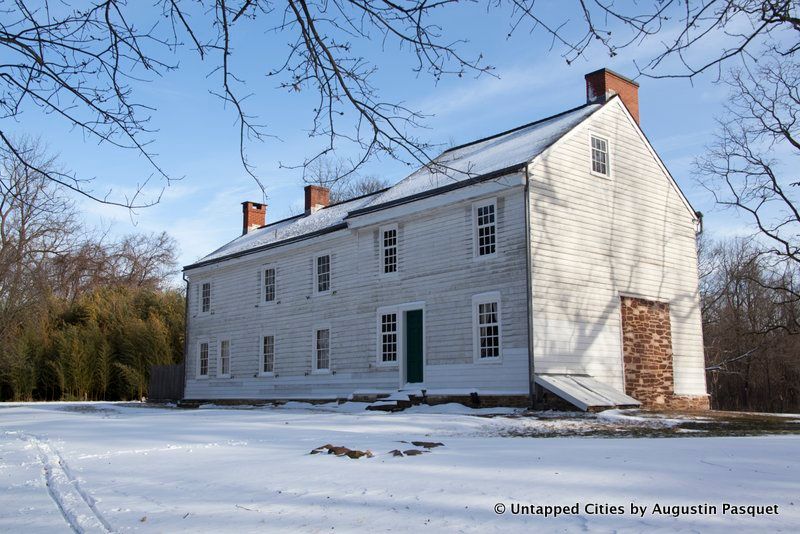
The Thomas Clarke House
The initial prompt for our day trip was to see the Princeton Battlefield, George Washington’s first personal victory over British forces and the culmination of the Ten Crucial Days Campaign during the Revolutionary War between December 25, 1776 and January 3, 1777 which began with Washington’s crossing of the Delaware River. An important portion of the land on which the battle was fought, locally known as Maxwell’s Field, was named by the National Trust for Historic Preservation as one of the seven Preservation Wins of 2016 for the successful preservation of 15 acres of the site, following a decade of uncertainty in the face of development by the Institute of Advanced Study, which planned to build faculty housing. The compromise agreement, negotiated by the Civil War Trust, allows the Institute to build on 7 acres, while keeping the battlefield’s primary area and open views. Efforts have already begun to return the battlefield to a level of foliage and tree cover that is more similar to the windswept field it would have been in 1776. For “Hamilton“ fans, Alexander Hamilton was an artillery captain, commanding a battery that was instrumental in the final phase of the Battle of Princeton.
While visiting the battlefield, don’t miss the Thomas Clarke House where Brigadier General Hugh Mercer, a Scotsman, died following injuries at the Battle of Princeton. Mercer “probably would have been very well known in American history had he lived,” says John, the resource specialist at the Princeton Battlefield State Park. Mercer County, one example of many, is named in honor of the general. Today, the Clarke House functions as a museum with its original 1755 portion showcased as a colonial farmhouse and an 1840s extension is used for exhibits.
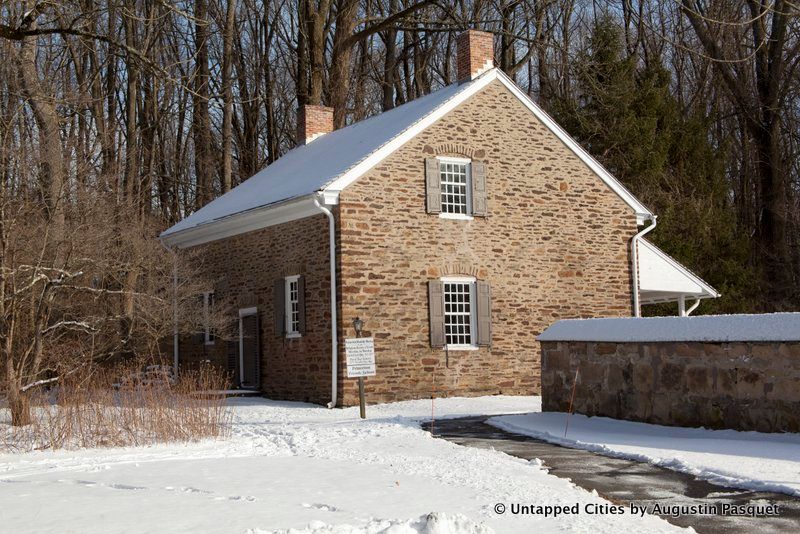
Quaker Friends Meeting House
Another site on the battlefield is the Quaker Friends Meeting House, where wounded soldiers were taken during the battle. The adjoining Quaker Cemetery is where Richard Stockton, one of the signers of the Declaration of Independence is buried. The Meeting House is still used by the Friends every Sunday and contains original wood floors and wooden benches.
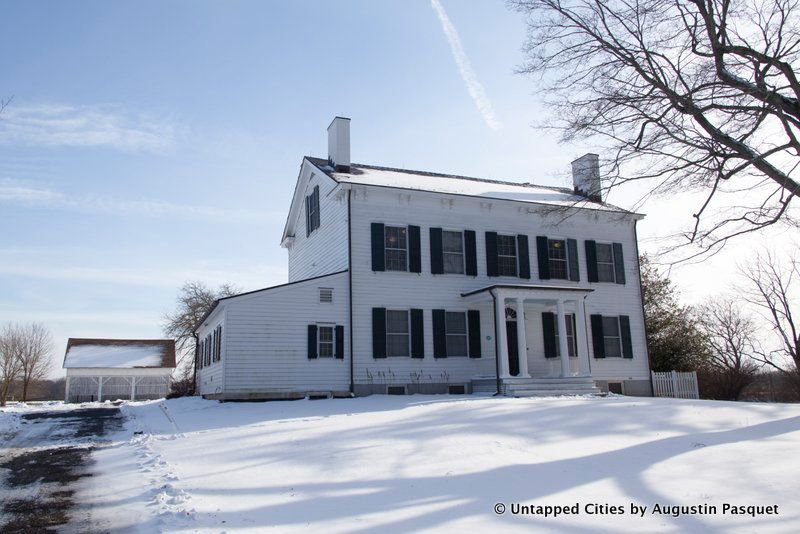
Also within the Princeton Battlefield area is the headquarters of the Historical Society of Princeton on the property that was formerly the Updike Farm, with structures dating to the 18th and 19th centuries. The Historical Society holds over 35,000 historic photographs of Princeton and its people. The main house is used for exhibitions and offices and the 1892 barn is currently being renovated into a programming and event space.

One of the highlights of the Historical Society is the Einstein Collection, one of the “larger 3D collections of Einstein materials in the United States,” says Izzy Kazdin, the executive director of the Historical Society of Princeton. The collection includes 65 pieces of furniture that were in the scientist’s house at 112 Mercer Street in downtown Princeton, where he lived when employed by the Institute for Advanced Study, a notable post graduate institution in Princeton.
The exhibit traces Einstein’s escape from Nazi-occupied Germany, describing how the scientist’s furniture was smuggled out of his Berlin apartment via diplomatic shipment under a different name. Archival photographs show Einstein sitting and using the furniture. On display currently include a beloved chair, a music stand used by Einstein when practicing violin, a grandfather clock and a record player.
Kazdin tells us that Einstein seems to have assiduously followed instructions from a telegram from the head of the Institute of Advanced Study to “enter this country quietly and inconspicuously,” even after his arrival. Contemporary newspapers write of the quest to track down Einstein, who would slip out back doors and enter at unexpected times, during events in Princeton.
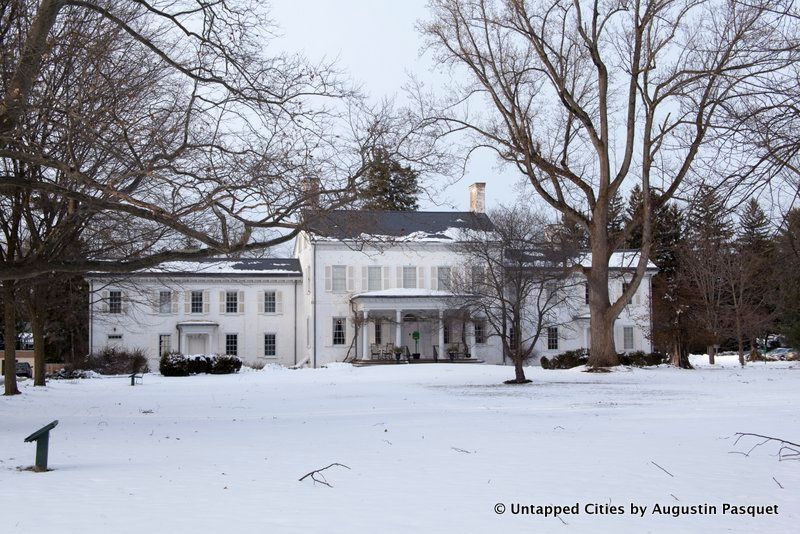
Much of the land in Princeton was part of the estate of Richard Stockton, one of the three signers of the Declaration of Independence from this town and a grandson of William Penn. Stockton’s mansion, known as Morven, later owned by Robert Wood Johnson of Johnson & Johnson, is a National Landmark and has also served as New Jersey’s first governor’s mansion.
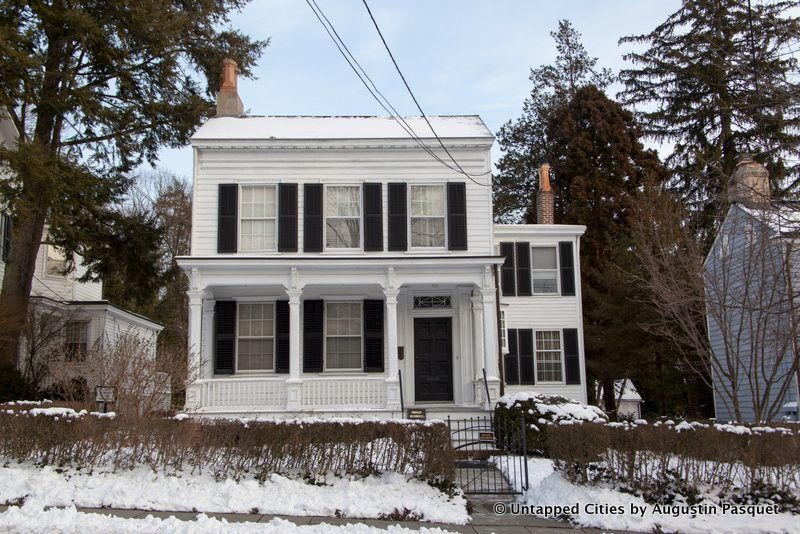
Albert Einstein’s House at 112 Mercer Street, where he lived starting in 1935
From 1933 to 1935, when Einstein arrived to Princeton at the Institute for Advanced Study, he lived in the side part of a Victorian house at the corner of Mercer Street and Library Place. In 1935, he purchased the house at 112 Mercer Street. Einstein stipulated that the house should never be turned into a museum after his death and it has continued to function as a home, with the Institute holding the right of first refusal whenever the home is sold. According to Mimi Omiecinski, owner of the Princeton Tour Company, it’s the only house where three Nobel prize winners have lived in: Einstein, Frank Wilczek and Eric Maskin.

Albert Einstein’s first home (side part of the house) in Princeton
Also don’t miss looking up at Einstein’s office on the second floor of Fuld Hall in the Institute for Advanced Studies.
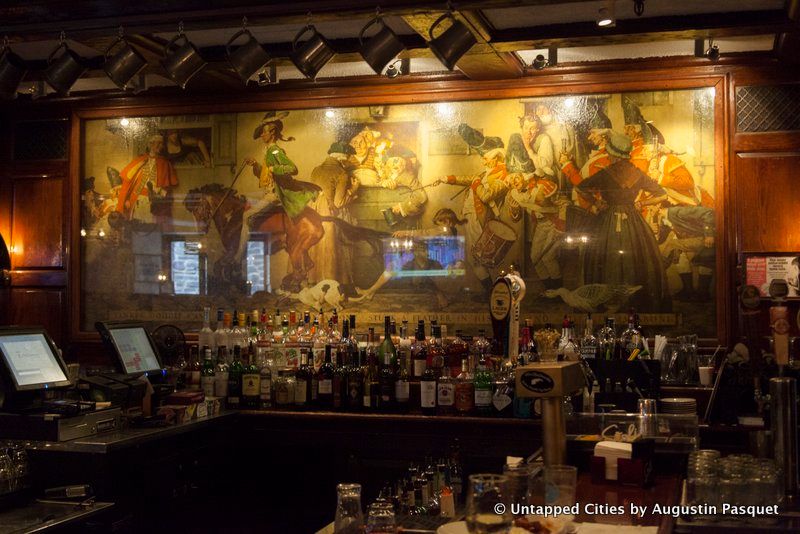
The Nassau Inn is located on Palmer Square, a central Princeton town square created as part of a urban redevelopment initiative. The Yankee Doodle Tap Room contains an original Norman Rockwell painting, depicting Yankee Doodle and the history of Princeton. It is one of few remaining in situ Rockwell paintings still in its original location, Omiecinski pointed out. This is the second iteration and location of the Nassau Inn, which played a role in the American Revolution and following, hosting members of the Continental Congress. Though the building design feels 18th century, with low ceilings, it only dates to the late 1930s, and contains original tavern tables from its earlier location carved through with the names of imbibers gone by.

Grover Cleveland Tower with the Class of 1892 Bells
Omiecinski, a Southerner herself, explains how Princeton got its Southern charm from a historical perspective. There were three crises of enrollment at Princeton, the first one due to the secularization of the country and education around 1812. Religious colonial families that once formed the bulk of the Princeton class felt uncomfortable with the shift and the school president headed down south to find the sons of wealthy plantation owners who could use an education – and one more conservative than could be found at Harvard or Yale. By the Civil War, says Omiecinski, “half of the student body was from the South.”
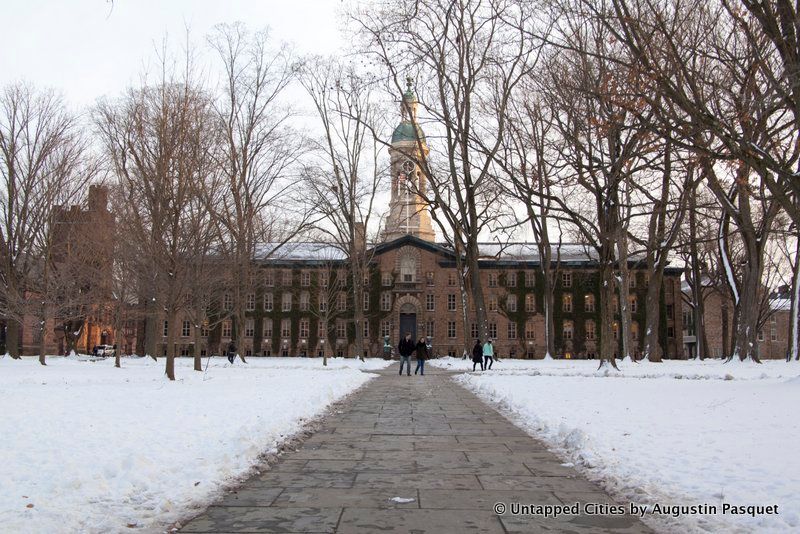
Nassau Hall, the oldest building on the Princeton campus built in 1756
The level of wealth and exclusivity from this Southern student body and the school’s donors explains Princeton’s relatively late move to integrate the school in terms of gender and race, but something the school has actively moved to counteract since.
Princeton, considered one of the most beautiful college campuses in the country, was intended by Woodrow Wilson to feel like Oxford with a predominantly Gothic architecture aesthetic, contrasted with Tudor revival buildings that line the main streets.
Two things to look out for: black stars below the windows of the dorms that mark Princeton students that fell in the various World Wars. Inside these dorm rooms are large plaques that tell the story of the student and how they died. Another spot is the Grover Cleveland Tower in the Graduate School, that contains a 67 bell carillon, known as the Class of 1892 bells. The bells, cast in England, France and the Netherlands, weigh from 14 pounds to 12,880 pounds.

This stucco house is where F. Scott Fitgzerald, a Princeton dropout from the class of 1917, lived in more low-income, freshman housing, explains Omiecinski. “F. Scott was living off his grandparents’ trust fund [but] that still made him low-income housing. He’s on the outside looking in on the Rockefellers…most historians say his placement, not only where he grew up in Minnesota, but also here on campus, solidified his obsession with social class. And don’t forget, in the backyard, the Nassau Club, the oldest private dining club in America.”

Another spot for Hamilton lovers, the President’s House at Princeton was first occupied by Aaron Burr Sr., the father of Aaron Burr of Hamilton notoriety and the founder of the College of New Jersey, which became Princeton. Burr senior was actually the second President of the college from 1748 until his death in 1757. Aaron Burr, Jr. entered Princeton at the age of 13 and graduated with a law degree by 16. In the musical, Hamilton says, “I heard your name at Princeton. I was seeking an accelerated course of study when I got sort of out of sorts with a buddy of yours. I may have punched him. It’s a blur, sir. He handles the financials?
[BURR]
You punched the bursar
[HAMILTON]
Yes!
I wanted to do what you did. Graduate in two, then join the revolution.
In real life, Hamilton didn’t punch the bursar but sparred verbally with then-president of Princeton, John Witherspoon.
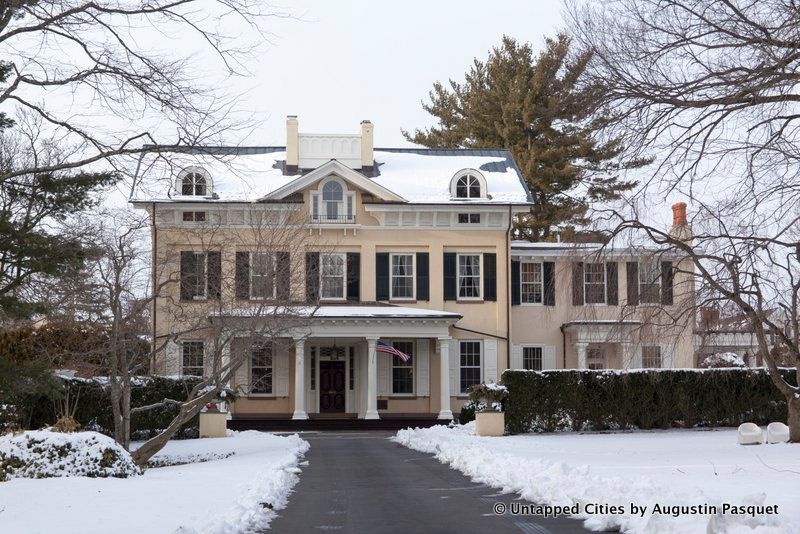
Home of Grover Cleveland
In the past, says Omiecinski, those who lived in the toniest neighborhoods of Princeton (within the former estate of Richard Stockton), could only be “academic celebrities and tycoons.” There you can still find gorgeous mansions that were home to the likes of President Grover Cleveland, President Woodrow Wilson, and William Bristol of Bristol Meyer Squibb. Today, you’ll see the home of Judy McCartin Scheide, who along with her husband (now deceased), gifted an immense collection of rare books and manuscripts to Princeton which include an original copy of the Magna Carta, the Declaration of Independence and the first Bibles ever printed.
Also don’t miss Drumthwacket, now the official residence of the Governor of New Jersey with its Guastavino tiling, most famously applied to places like Grand Central Terminal and Ellis Island. Once up to 183 acres in size, the estate now covers nine acres with a beautiful mansion which is open for guided tours.

A visit to Princeton would not be complete without a visit to the Birch Avenue area to reflect on the role African Americans have played in the development of Princeton town and campus. While this working-class community previously centered around what is now Palmer Square, urban development plans led to the relocation of the community to Birch Avenue and surroundings, where they have continued to fight displacement over the decades. Among the notable from the community include Paul Robeson, the first African American to perform on Broadway (known for singing Ol’ Man River in Showboat). The Historical Society of Princeton has a map you can follow for a walking tour of the neighborhood.
Adjacent to this neighborhood is the Princeton Cemetery, where you’ll find the grave of Grover Cleveland, Aaron Burr and his father, the daughter of Joseph Stalin, George Gallup (of the Gallup poll) and many other notable Americans.
Princeton is an easy day trip from New York City, or an overnight weekend stay for more extended exploration. Start with the Historical Society of Princeton and the Princeton Battlefield, and explore the town’s rich history over the course of centuries, check out the Princeton Tour Company for guided walking tours, and follow the path of the 10 Crucial Days Campaign with the Princeton Battlefield Society.
Next, check out the 10 historic mansions to visit on Long Island’s Gold Coast.
Subscribe to our newsletter